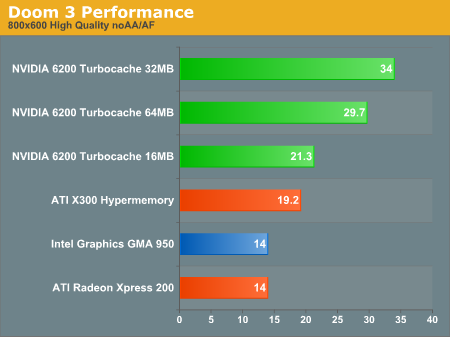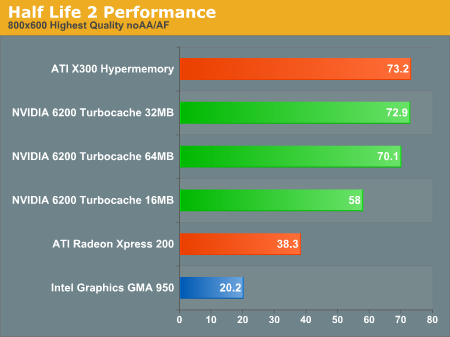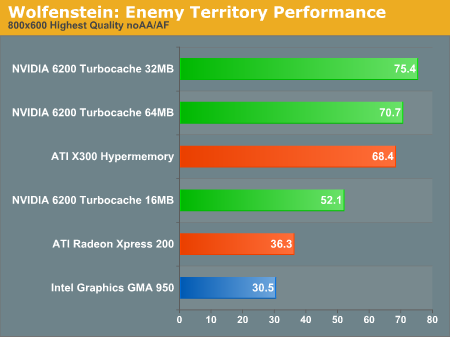
Original Link: https://www.anandtech.com/show/1693
Integrated Graphics: Xpress 200 vs. GMA 950
by Derek Wilson on May 26, 2005 12:00 AM EST- Posted in
- GPUs
Introduction
We spent some time testing ATI and NVIDIA's latest low end parts recently. Today, we are revisiting budget performance. After all, what's more "budget" than dropping the graphics chip on the motherboard?The real reason for the existence of the 6200 TurboCache and the X300 HyperMemory is to provide an affordable setup up from integrated graphics. Graphics companies have to be quite careful when developing integrated and budget cards to not cannibalize their business for either product. There must be sufficient performance on integrated graphics to run current software so that end users are satisfied, but cheap budget cards also need to provide a sufficient step up from integrated solutions.
It is difficult to get the level of performance that we want to see in integrated graphics, but it is important to consider the fact that users of integrated graphics may not need any 3D support and would certainly not want to pay for it. Cost is a first concern, and compatibility reigns over performance.
So, how does this generation's integrated graphics perform compared to the recent budget cards on the market? Well, that's what we are here to find out.
From ATI, we have the Radeon Xpress 200 for Intel platforms. We will be pitting this solution against the Intel GMA 950 on our 945G board. These integrated graphics cards will be compared to our recent discrete budget graphics tests. Even though the platforms won't be as similar to what we usually want, these tests are bound by the graphics capabilities of the cards almost completely. We should get a good idea of how these parts stack up against each other.
The Test
Our test will involve the Intel D945GTP and the ASUS P5RD1-V Deluxe board. There are a few caveats in looking at these solutions compared to each other and our previous budget card tests. First of all, though the Intel platforms can use the same processor, we are stuck with DDR 400 for our ASUS board. The 945G board uses DDR2 533. As we will see, this won’t change the outcome of our tests. There will be ATI boards featuring DDR2 as well, but the advantage (if there is one) is minimal.Our setups were as follows:
Intel D945GTP
3.6GHz Pentium 4
1GB 533MHz DDR2 3:3: 3:12
Seagate 7200.7 120GB HD
ASUS P5RD1-V Deluxe
3.6GHz Pentium 4
1GB 400MHz DDR 2:2:2:8
Seagate 7200.7 120GB HD
We will run our tests with high quality settings in order to see if integrated graphics are as capable as the budget add-in cards that we tested recently. This will also demonstrate minimum performance in the games that we test, as end users will likely want to sacrifice some of the eye candy for playability.
Doom 3 Performance
As Doom 3 generally runs at very low frame rates, it is not surprising that our integrated tests turned out some pretty horrific performance numbers. Really, integrated hardware at low quality and 640x480 is still not acceptable. Doom 3 really necessitates a discrete card to be enjoyable. We will have to wait and see if this verdict applies to all games based on the Doom 3 engine as well. Hopefully, other developers will have figured out how to accommodate the worst case scenario while we wait for integrated performance to continue to improve.

Far Cry 1.3 Performance
Unlike the last time that we tested Far Cry with Intel graphics, we were greeted with the visual quality that we expected to see. This is due to the driver revisions that Intel has made over the course of time. Of course, that doesn’t mean performance is any good. With the lowest quality settings, Far Cry is barely playable at the lowest resolutions on the GMA 950. ATI’s Xpress 200 is able to pump out enough performance to play the game, but to run at over 20fps, lower quality settings must be enabled. Most of the appeal of Far Cry is, of course, its visual impact. Games like these really need to do more than simply run on integrated hardware.

Half Life 2 Performance
Once again, we were quite surprised by Valve's Source engine. These numbers are quite good for integrated components. The visual quality did not disappoint on either ATI or Intel hardware. The hardware support for the GMA 950 was listed as DX 8.1 rather than DX 9, but as we saw when we looked at the older NVIDIA hardware, the only real difference between the two rendering modes is in the water quality.The fact that Intel's hardware performed the same at all three resolutions tested makes us think that Valve has built in some sort of minimum frame rate maintenance mechanism into Source. Playing on higher resolutions made it more difficult to interact smoothly with the world, but visually, there weren't many sacrifices. Again, nothing that a gamer would touch with a 50-foot pole, but casual home and business users who may want to play a game will be able to do so. And surely all parties involved will be hoping that the taste of what could be will inspire computer users everywhere to upgrade their hardware and software.

Unreal Tournament 2004 Performance
As Unreal Tournament 2004 sports graphics based on older DirectX 7/8 code, the game serves as a good indicator that integrated graphics can handle older games at playable frame rates. Turning down some of the settings also grants a little headroom. The ATI solution again proves itself better than the Intel part in terms of performance.

Wolfenstein: Enemy Territory Performance
Another game based on older technology (and OpenGL), Wolfenstein gives the highest frame rates that we’ve seen on integrated hardware. Intel lags in performance once more, but with 30fps at high quality 800x600, dropping the settings a bit more will give a surprisingly smooth experience.

Final Words
These numbers serve to show that spending 50 to 75 USD on an add-in card can actually make the difference between a good gaming experience and a mediocre one. We chose not to highlight the fact that disabling advanced features, shaders, and effects do serve to boost performance to playable levels on today’s integrated platforms because the gap between lowest and highest quality on modern games continues to widen. The major advantage of current generation budget cards is not that they can deliver incredible performance, but that they can deliver something playable without sacrificing image quality to do so.For those who truly do not need or care about 3D, integrated graphics are fine. People who are nostalgic about Quake III and earlier 3D games will also be satisfied. If just running something with 3D is important, these solutions will get the job done. But integrated performance has still not reached a level where we can recommend it to anyone who wants to play the current generation titles.
We see the difficulty from a business standpoint of integrating products that compete with discrete budget parts, but we still feel that offering the option of slightly higher quality 3D onboard would be a welcome move. Intel has no motivation to do anything, but the minimum required by Microsoft for Longhorn as their loyalty lies with business customers. However, it seems that ATI and NVIDIA have an opportunity to compete with Intel by simply offering better 3D support along side their outstanding 2D functionality.
Out of the integrated cards that we tested, the ATI part came out on top in the performance tests. We can also expect ATI to put more effort into supporting (at least on some level) the latest games than Intel. On the other hand, Intel ships more graphics components than any other manufacturer in the world. We can expect their home and business graphics support to be of the same quality of which they provide for all their other components.
It is still a great thing that Intel and ATI have moved beyond the Extreme Graphics era where 3D applications would run very poorly (if at all). Compatibility is the first step, and performance of this generation of integrated components is indeed a step up from what we’ve seen in the past. Let us hope that the progression continues.







